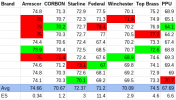I thought it would be better to bump an old thread than to create a new one on a topic that's already been covered:
Yesterday I went to the range before work and tested some handloads. I'd made up six different loads. The difference between them was powder charge and overall length of the cartridge (COAL). I did a "plunk test" to determine my max COAL:
Going by the advice in this guy's vid, my max COAL was 1.14", which I loaded three of the loads to. After looking at them, I thought they just didn't look right: the bullet's wax groove was sticking way out the end of the case and that didn't seem right so I made the three loads again but with a COAL of 1.06", which placed the wax ring just inside the case mouth.
The longer COAL rounds were a) unreliable (had to smack the slide shut after almost every round), b) inaccurate (all loads printed high, some rounds going over the top of the paper), and c) inconsistent (groups ranged from 4-7", not counting the rounds that went over top of the paper, which I can't measure, of course).
By contrast, the shorter rounds were a) 100% reliable, b) shooting to POA, and c) giving me groups of about 2.5".
The recoil of the shorter rounds was quite nice and there were no obvious signs of high pressure.
Is that Plunk Test a bunch of voodoo? After doing it I learned how long of a cartridge I could load, but the stuff I made up was worse in every way than the ammo whose COAL I came up with by seating the bullet deeper and deeper until I thought to myself "Yep, that looks about right." There's lots of info online about rifle COAL but not so much for pistol. Is there any scientific reason to pick a COAL/seating depth with pistol rounds or is what I did (i.e.: throw spaghetti at the wall and see if it sticks) as good a method as any? I could see being more cautious if you were using a max powder charge, but I wasn't even close.




